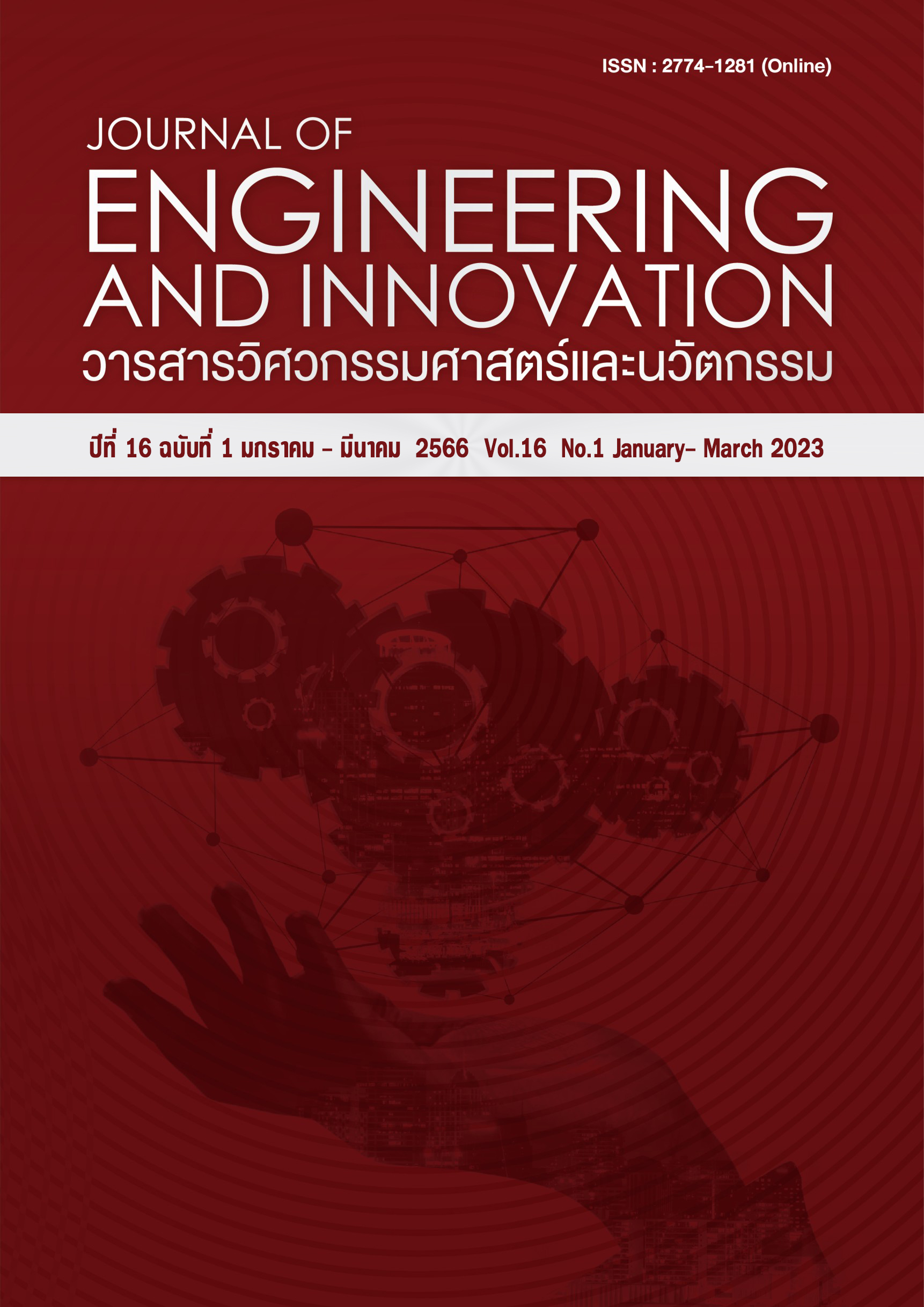Production sequence using simulation technique: A case study of feed factory for dairy cows
Main Article Content
Abstract
The objective of this research was to apply the Flexsim® simulation program to find the most suitable production sequence for the case study factory. The researchers experimented and found the most appropriate production sequence by entering 25 jobs with the total production amount of 520 tons into the simulation model and experimenting with the production order of Earliest Due Date (EDD), Least Work Remaining (LWKR) and Most Work Remaining (MWKR) by experimenting with 30 replications in each format. Based on the analysis of the experimental results, it was found that the current production sequence of the factory has a makespan time of 200.71 hours and the number of tardy jobs is 3 jobs. The EDD production sequence has a makespan time of 170.58 hours without tardy jobs. The LWKR production sequence has a makespan time of 167.54 hours without tardy jobs. The MWKR production sequence has a makespan time of 171.73 hours and the number of tardy jobs is 6 jobs. From the experimental results, it was found that the LWKR production sequence is most suitable because the makespan time is 167.54 hours which is the smallest production time and can reduce operation time by 19.8 % without tardy jobs.
Article Details
References
ศูนย์เทคโนโลยีสารสนเทศและการสื่อสาร กรมปศุสัตว์. ข้อมูลเกษตรกรผู้เลี้ยงสัตว์ระดับจังหวัด ปี 2562. เข้าถึงได้จาก: http://ict.dld.go.th/webnew/index.php/ th/service-ict/report/323-report-thailand-livesto ck/reportservey2562/1372-2562-prov [เข้าถึงเมื่อ 1 กันยายน 2563]
Marcello F, Fabio F, Alfredo L, Giada M, Maria EN. Production scheduling approaches for operations management. In Operations Management. Hong Kong: The Open University of Hong Kong; 2013.
Robert ES. Introduction to simulation. In: 24th conference on Winter simulation. Virginia, USA; 1992. p. 65–73.
สุทธิดา เอี่ยมสำอางค์, อธิวัฒน์ บุญมี. การจำลองสถานการณ์เพื่อปรับปรุงกระบวนการทำงานของสายการผลิตสับปะรดบรรจุถุง: กรณีศึกษา. วารสารวิชาการ วิศวกรรมศาสตร์ ม.อบ. 2563; 13(1): 114–126.
Stadnicka D, Antonelli D, Bruno G. Work sequence analysis and computer simulations of value flow and workers’ relocations: A case study. Procedia CIRP. 2017; 62: 159–164.
อรรถกร เก่งพล, วุฒิชัย ยังสว่าง. การประยุกต์ใช้วิศวกรรมคอนเคอร์เร็นท์และการจำลองสถานการณ์ในการเพิ่มความสามารถในการผลิตของกระบวนการดัดท่อ: กรณีศึกษา บริษัทผลิตท่อน้ำมัน. วารสารวิชาการพระจอมเกล้าพระนครเหนือ. 2558; 25(2): 233–242.
Kusoncum C, Sethanan K, Putri EP, Neungmacha W. Simulation-based approaches for processes improvement of a sugar mill yard management system: A Case study of the sugar industry in the central region of Thailand. Engineering and Applied Science Research. 2017; 45(4): 320–331.
ชยุตม์ บรรเทิงจิตร. การประยุกต์ใช้เทคนิคการจำลองสถานการณ์ในการออกแบบผังคลังสินค้าเพื่อลดเวลาในการขนถ่ายวัสดุ. วิศวกรรมสารเกษมบัณฑิต. 2561; 8(3): 1–14.
พัฒนพงศ์ น้อยนวล, ธนัญญา วสุศรี. การปรับปรุงกระบวนการการขนส่งภายในคลังสินค้า โดยใช้แบบจำลองสถานการณ์ กรณีศึกษา อุตสาหกรรมน้ำอัดลม. วารสารวิจัยและพัฒนา มจธ. 2555; 35(3): 323–334.
Kluska K. Automatic simulation modelling of warehouses. LogForum. 2021; 17(1): 59–69.
ศศิวรรณ รัตนอุบล, ชานินทร์ ศรีสุวรรณนภา. การจำลองสถานการณ์เพื่อเพิ่มประสิทธิภาพการให้บริการของคลินิกกุมารเวชและอายุรกรรม ตึกผู้ป่วยนอก โรงพยาบาลพัทลุง. วารสารวิทยาศาสตร์ลาดกระบัง. 2556; 22(1): 107–116.
พรพิมล ชัยวุฒิศักดิ์, วริยา ยังไว, วีรชัย มีสัตย์, ศุภวิชญ์ สมเกียรติวีระ. การจำลองระบบแถวคอยเพื่อเพิ่มประสิทธิภาพการให้บริการแผนกผู้ป่วยนอก : กรณีศึกษาโรงพยาบาลเมืองปาน จังหวัดลำปาง. วารสารวิทยาศาสตร์ลาดกระบัง. 2563; 29(1): 10–23.
กสิณ รังสิกรรพุม. การวิเคราะห์การไหลของจราจรที่สี่แยกไฟจราจรด้วยเทคนิคแบบจำลองทางคอมพิวเตอร์. วารสารไทยการวิจัยดำเนินงาน. 2563; 8(2): 1–14.
Chanthakhot W, Ransikarbum K. Integrated IEW-TOPSIS and Fire Dynamics Simulation for Agent-Based Evacuation Modeling in Industrial Safety. Safety. 2021; 7(2): 47.
Simon F. Sequencing and scheduling: An introduction to the mathematics of the job-shop. New York: Eellis Horwood Ltd.; 1982.
Kenneth RB. Introduction to sequencing and scheduling. New York: John Wiley & Sons; 1974.
ธีรเดช วุฒิพรพันธ์. วิธีการจัดลำดับและการจัดตารางการผลิต. กรุงเทพฯ: อมรินทร์; 2559.
พัชราวลัย แสงอรุณ. การจัดตารางการผลิต : กรณีศึกษาโรงงานผลิตคอมเพรสเซอร์. วิทยานิพนธ์วิศวกรรมศาสตรมหาบัณฑิต สาขาวิชาวิศวกรรมอุตสาหการ, จุฬาลงกรณ์มหาวิทยาลัย. 2545.
วิภาพร จินาวรณ์. การจัดลำดับการผลิตและการจัดตารางการผลิตเพื่อลดปัญหาการส่งมอบล่าช้า: กรณีศึกษาโรงงานประกอบชิ้นส่วนอิเล็กทรอนิกส์ด้วยเครื่อง SMT Machine. วิทยานิพนธ์วิทยาศาสตรมหาบัณฑิต สาขาวิชาการจัดการโซ่อุปทานแบบบูรณาการ, มหาวิทยาลัยธุรกิจบัณฑิต. 2554.
ยอดดวงใจ นาคปฐม. การจัดตารางการผลิตแบบตามสั่งสำหรับอุตสาหกรรมสิ่งทอ. วิทยานิพนธ์วิศวกรรมศาสตรมหาบัณฑิต สาขาวิชาการจัดการงานวิศวกรรม, มหาวิทยาลัยศิลปากร. 2555.
สมโภช น้อยปลอด, ดำรงเกียรติ รัตนอมรพิน. การปรับปรุงการจัดตารางการผลิตแบบมุ่งเน้นกระบวนการ กรณีศึกษาโรงงานผลิตชิ¬นส่วนทางอากาศยาน. วารสารสถาบันเทคโนโลยีไทย-ญี่ปุ่น : วิศวกรรมศาสตร์และเทคโนโลยี. 2556; 1(1): 63–67
Ingolf S, Raymond RH, Joan MD, Henry H, Catherine MH, David K. Teaching the classics of simulation to beginners (panel). In: 35th Winter Simulation Conference. Louisiana, USA; 2003. p. 1941–1951.
ศิริจันทร์ ทองประเสริฐ. การจำลองแบบปัญหา= Simulation. พิมพ์ครั้งที่ 2. กรุงเทพฯ: โรงพิมพ์แห่งจุฬาลงกรณ์มหาวิทยาลัย; 2537.
Anu M. Introduction to modeling and simulation. In: 29th Winter Simulation Conference. Georgia, USA; 1997. p. 7–13.
ศิวรักษ์ อินต๊ะวงค์, สันติชัย ชีวสุทธิศิลป์. การเพิ่มประสิทธิภาพการจัดตารางการผลิตโดยวิธีฮิวริสติกและเทคนิคการจำลองแบบปัญหาในอุตสาหกรรมประกอบชิ้นส่วนอิเล็กทรอนิกส์. วารสารวิศวกรรมศาสตร์ มหาวิทยาลัยเชียงใหม่. 2553; 17(2): 55–62.
สโรชา เกษแก้ว, อุดม จันทร์จรัสสุข. การหาค่าที่เหมาะสมที่สุดโดยใช้การจำลองสถานการณ์ในการปรับปรุงกระบวนการผลิต กรณีศึกษา บริษัท ทีทีเอช เทรดดิ้ง จำกัด. วารสารข่ายงานวิศวกรรมอุตสาหการไทย. 2559; 2(3): 23–32.
Fadi S, Joaquin OM, Alvaro GS, Miguel OM. Optimizing the production scheduling of a single machine to minimize total energy consumption costs. Journal of Cleaner Production. 2014; 67: 197–207.
Marco S, Julia R, Cinna S, Jürgen Z. Machine scheduling in underground mining: an application in the potash industry. OR Spectrum. 2016; 38(2): 365–403.
Youlong L, Jie Z, Wei Q. Simulation-based production analysis of mixed-model assembly lines with uncertain processing times. Journal of Simulation. 2018; 13(1): 44–54.
Zineb IMH, Abdellah EB, Ikram EA, Abdelouahhab J, Abdel MD. Planning and scheduling of production system in conditioning line: Industrial application, Optimization and simulation approach. Management & Production Engineering Review. 2019; 10(4): 3–10.
Sargent RG. Verification and validation of simulation models: an advanced tutorial. In: 2020 Winter Simulation Conference. Florida, USA; 2020. p. 16–29.
Ransikarbum K, Kim N, Ha S, Wysk RA, Rothrock L. A highway-driving system design viewpoint using an agent-based modeling of an affordance-Based finite state automata. IEEE Access. 2018; 6: 2193-2205.

